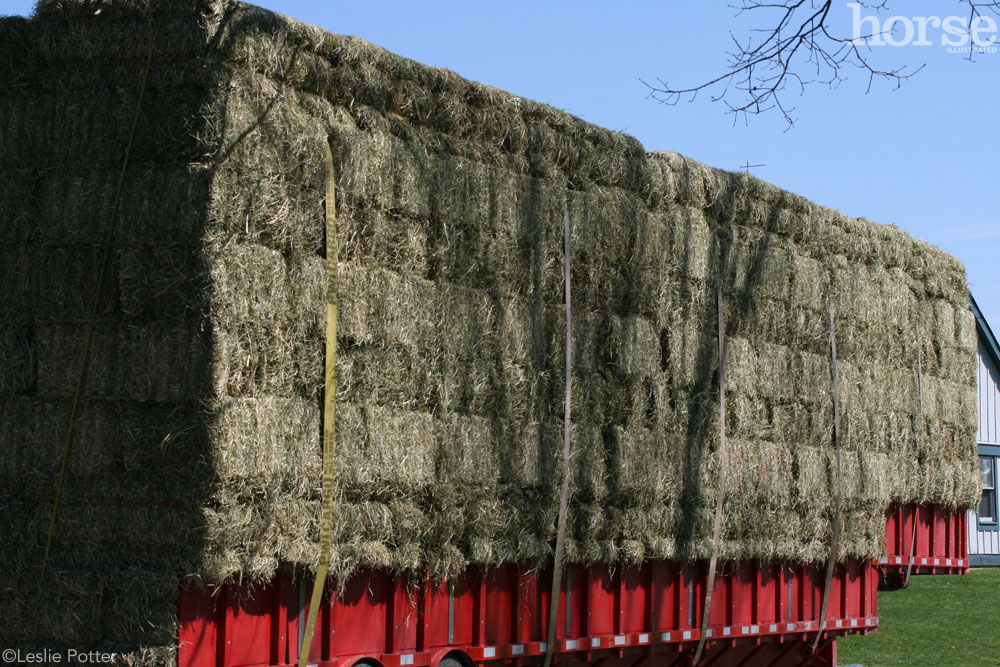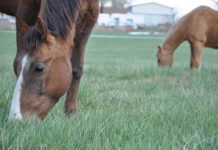Beth’s on the phone giving directions to the truck driver who’s delivering the first of two semi-loads of hay that she and her neighbors paid for in-full months prior. They found an out-of-state custom hay company on the Internet, hoping to avoid the hassles of finding hay locally during a year of drought and wildfires.

After the driver verifies the address and directions, he adds, “It’s the nicest load of alfalfa hay I’ve seen in a long time.”
“Alfalfa?” Beth asks. “It’s supposed to be grass hay.”
Hay-buying horror stories abound, and on both sides of the feeder. Sellers share tales of horse owners who want a refund because there are grass seeds in their grass hay or who expect every bale of grass/alfalfa mix to have a specified and consistent grass-to-alfalfa ratio. Buyers complain of short and underweight loads, broken promises, moldy or otherwise unusable hay, failure to deliver or deliveries purposely made in the dark to hide a bad product and more.
Fortunately, there are some steps you can take to make the process less stressful for all involved. After all, wouldn’t it be nice to develop a mutually trusting relationship with a hay provider who will reliably supply your hay for many years to come?
Step 1: Find a Reputable Hay Provider
Start your search for a hay provider months before you need hay. The time researching a reliable source is well spent when you know you’ve found an honest, professional outfit.
“Word of mouth is the single best way to find a hay provider you can trust and with whom you can develop a long-term business relationship,” suggests Cherry Hill, author of more than 30 books and videos on horse care and training. Cherry has kept and fed horses from Alaska to Arizona and everywhere in between.
Sue Littlefield, whose eastern Colorado-based L7 Ranch has been providing hay to numerous horse, cattle and llama owners for 15 years, agrees. “Ask your vet, farrier, trainer and fellow horse owners for their recommendations.”
Internet searches can be useful, but remember that it’s easy to create a professional looking website, so be a careful consumer when researching hay providers online.
Keep a notebook with your findings. You never know when circumstances may change and you will need to find a new supplier.
Step 2: Interview Prospective Suppliers
When you’ve found two or three sellers who sound promising, give them a call and ask some questions. “You can tell a lot about sellers, the quality of the hay they offer and how they treat their customers just by talking with them,” Sue says. “For example, how long has the seller been in business? Does the seller have an established relationship with the grower? Does the seller use the hay [for its horses]? In our case, we feed the hay that we sell to our own livestock, and we’re particular about quality, so our customers benefit from our knowledge.”
Sue also suggests asking whether the seller is knowledgeable about the hay from a nutritional standpoint. Also inquire about whether the seller markets primarily to horse owners or to the cattle industry. Cattle can tolerate lower-quality hay than horses without risking health problems, so there may be different perceptions as to what constitutes good quality hay.
If the seller is out of state, ask if he/she delivers to any horse-owning customers near you so that you can see the hay quality offered. If the seller is local, ask when you can come out and see the hay for yourself.
“Be sure to ask what happens when you find moldy, extremely dusty or otherwise unusable hay,” Cherry adds. “Being a product of nature, no hay is perfect and there is generally some waste. Ask the seller if he or she will give you credit [for bad hay] or otherwise provide a mutually agreeable solution.”
“An honest hay seller wants your continued business, provided you are reasonable in your expectations and requests,” Sue says. “Such sellers frequently will make things right one way or another.” If the seller offers no solutions, that can tell you a lot about how that company does business.
Step 3: Check References
A good hay provider should have a long list of satisfied customers and will be happy to share some names and numbers with you. Call the references and ask questions, and listen carefully to the answers. If the references keep mentioning other hay providers that they’ve heard are good, they may be trying to tell you something. Remember, too, that unsavory hay sellers may give you names of people posing as customers who, of course, say only positive things.
Step 4: Buy as Much Hay as You Can
It’s a great idea to buy as much hay as you can—and even buy more hay than you think you’ll need. This creates a cushion if there are some unusable bales, if your next hay delivery is delayed or if you end up feeding more months or more mouths than you originally anticipated.
“Horses thrive on consistency, and it’s always best to buy the largest quantity of hay from a single source. An entire year’s worth is ideal,” Cherry says, “and buying a large quantity of hay costs substantially less than buying it from the feed store.”
If you have hay delivered, it’s usually less expensive to buy an entire stacker load (about 5 tons) or an entire semi-load (about 17 to 20 tons). If you can’t use this much hay, check to see if your neighbors might be interested in splitting a load.

You might also try asking your hay supplier if you can pre-pay for all your hay needs and get deliveries as you run low. Remember, however, that your hay supplier is not a bank.
“The seller has already invested money, labor and storage costs for the hay you want to buy later, so expect to pay a storage fee, an increased price per bale or ton as the year continues, or some other charge to cover the costs and risks of holding your hay,” Sue says. “Some suppliers may be able to work with you on these options, and some may not.”
Step 5: Delivery or Do-It-Yourself
When buying hay, you need to decide whether you’ll pick it up yourself or have it delivered.
Picking it up yourself: This option involves quite a bit of your labor and time, but it can be less expensive than delivery. However, with rising fuel costs you’ll need to do some comparisons of delivery charges versus your costs and your time.
“You can inspect hay before you buy and, within reason, pick the bales you want,” Cherry says. “However, if you look at some hay several weeks before you’re ready to buy, be aware that the hay you saw may be sold by the time you arrive, and the hay that is now available may not be as good.”
Delivery: You’ll pay the seller or a hay hauler to deliver the hay to your location. Some delivery companies will also unload and stack hay for an additional price, while others will require you to do this yourself or hire help.
When you rely on someone else to deliver your hay, you don’t have absolute say in when it will be delivered. Companies usually can give you a few days’ notice and possibly a window of time for delivery, but you’ll need to be flexible. Your hay may also be rained on in transit, although you may be able to request the load be tarped for an extra fee.
Step 6: Agreements and Payment
Many hay providers and growers work from a verbal agreement or over the phone. Still, see if you can jot down your order in writing, or send an e-mail or fax with your requests: type of hay, amount of hay, price, delivery timeframe and so on. A written note protects both the buyer and seller, but realize that a lot of sellers just don’t use written contracts.
How you pay for hay is largely up to the seller, so be sure to agree to the terms when you order your hay. Realize that it’s risky for the buyer to prepay in full for a large load of hay, and it’s risky for the seller to deliver it COD. Understanding on both sides can lead to a fair and workable solution.
If you’ve never worked with a particular seller whose company requires up-front payment, see if you can pay a portion of the cost when you order and pay the remainder upon delivery.
And while some sellers will accept personal checks, don’t be surprised if they ask for a cashier’s check or cash. Some take credit cards.
Step 7: Inspecting Delivered Hay
When your truck loaded with hay pulls up, you can usually get a general idea of quality by looking at color, stem sizes, maturity of seed heads, smell and so on.
There are times, however, when you look at the hay and know—with a sinking feeling in your stomach—that it’s not what you ordered. Can you refuse the load?
“Stick to your guns and get what you ordered,” Cherry says. “But also realize that you’re in a sticky situation if you refuse a load of hay. It has to be for good reason [such as the wrong type], and not because the hay isn’t quite as green as you’d prefer or because you see more seed heads than you’d prefer.”
Remember also that there are many variations in mixed hay. “There’s no way for a grower or seller to accurately specify a certain percentage of grass versus alfalfa,” Sue says. “Every bale will be different.”
If you specified straight grass hay with no alfalfa, and you see the telltale stems and leaves of alfalfa, you’d be within your rights to refuse the hay. But beyond that it may come down to your opinion versus the seller’s as to what constitutes “good hay.”
“A reputable hay provider doesn’t want you to refuse a load any more than you do,” Sue says. “These sellers will do what they can to be sure the hay is what you are expecting.”
Step 8: Getting What You Paid For
Cherry suggests, “Before unloading, if you have access to a moisture meter, probe the load for moisture content.” Although moisture content does vary slightly between grass hay and alfalfa, with grass hay usually having a slightly lower moisture content, both should fall within the moisture safety guidelines.
“Ideally, hay should be between 15 and 18 percent moisture,” Cherry says. “Over 20 percent and the hay is likely to spoil and could catch fire. If you are unloading small square bales, toss about 20 random bales into a pile to be weighed and sampled. Use a portable hay scale (available in many horse-supply catalogs and feed stores) to get an average bale weight. This will give you a good estimate of bales per ton to compare with the weight on the weight slip.”
If your agreement is to pay by the bale, have someone specifically counting bales as they come off the truck. An easy way is to unload the truck, layer by layer, counting bales in each full layer.
Without a coring tool, which carves a tubular core of hay out of a bale so that it can be sent to a lab for analysis, it’s difficult to tell the internal quality of baled hay without opening bales. Again, this is where a trusting business relationship with your hay provider really pays off. A respectable seller gains nothing by selling you inferior quality hay—neither party benefits if the load is rejected.
“Your hay seller should be taking the responsibility to inspect the hay before it’s ever brought to you,” Sue says. “That’s what you’re paying your seller for—to make the process as painless as possible.”
If you order a semi-load of hay and pay by the ton, the driver may have a weight slip for the load. The weight slip gives you a good idea of how much hay you’re buying and is just one more tool to be sure you’ve gotten what you paid for. However, weight slips can be manipulated and they are not required, so the presence or lack of one doesn’t guarantee anything.
Step 9: Storage Tips
It’s always best to store hay in a covered hay shed or barn away from the horses. If you must store hay outside, stack it on pallets and cover it correctly to avoid “stack damage” that occurs when water seeps into the bales from a damaged tarp or wicks up from underneath.
Other tips include:
- Locate the stack on a high point where water and snow don’t collect.
- Ideally, put the stack where it will be easily accessible in the worst blizzard or rain storm.
Ensure air circulation around the stack to keep it dry. - Cover with overlapping tarps and secure tightly. Several products are available to tighten tarps.
Canvas hay tarps are the best; however, make sure they are waterproof canvas or treated canvas. These types of tarps are expensive but will last a long time. Blue polyethylene tarps are inexpensive but will only last one or two seasons before they deteriorate from the elements. Black plastic is not a good choice as it tears easily, is difficult to secure and can allow condensation to accumulate.
Few things are more comforting to a horse owner than a fragrant shipment of new hay safely packed away. The only thing better? Knowing that next year all you’ll need to do is call your trusted hay supplier and put in your request.
Estimate your monthly and annual hay costs.
This article originally appeared in the October 2006 Horse Illustrated. Click here to subscribe.







one of my friends who owns horses started buying from a haydealer and was getting a raw deal the quality was poor people are out there to make money more so now with the economy so bad and not caring about the consumer.we had found a great hay dealer he delivers himself and she and everyone she knows swears by his hay and his caring about the consumer took some searching and if ya ever in need of quality hay and good prices just call him
the hay man 352-535-7202 they wont buy anywhere else now
good info!
I am a hay producer, and I liked this article so much I would like to add it to my web page giving credit to all involved in the development of the article . So I am asking permission to use this article, and what I will have to do in order to post it on my web page http://www.hay4horses.com?
Thanks
Skip Matthews
skijeam46@gmail.com
Phone: 318.987.3531
Cell: 870.843.0297
he lost alot of customers due to poor quality
was charging us for wet hay.352-535-7202
I like your article and feel like i am the hay supplier you were talking about. Im a grower of midland 99 bermuagrass and i take care of my hay like you take care of your horses. If you will try my hay one time you will be asking yourself where have you been all my life. I know how to take care of hay so lets get together. I will take care of your horses needs guaanteed.
My ad appears on this page about midland 99 bermudagrass. My phone is 580-583-4920 and my email is mikel_2246@yahoo.com This hay usually runs around 15 or 16 % protein but with an experiment this past year i raised that to 21.5 % but it is too expensive for me to, but for a price and if you have a need for very high percentage of protein I can do that. Call me or email me soon
Lovell Farms
I have more of a question then a comment. I was told from a friend that clean fertilized crabgrass hay is as good or even better than most Bermuda hay and the animals seem to prefer it. I found a lot of information to back this up on the internet. I was given a couple bales from my friend and feed it to both my horses and cows along with a few bales of good quality coastal I bought from my local feed store. My friend was right. My animals took right to the crabgrass hay over the coastal. I would like to hear your opinion on this matter.
Thank you.
Well written! This articles points are excatly how a good hay buying or selling experience should be done. I am a Quebec hay supplier to many feed stores and horse ranches to the eastern United states. We have over 50 suppliers and absouletly take pride in giving a great service with the hay the customer wants.